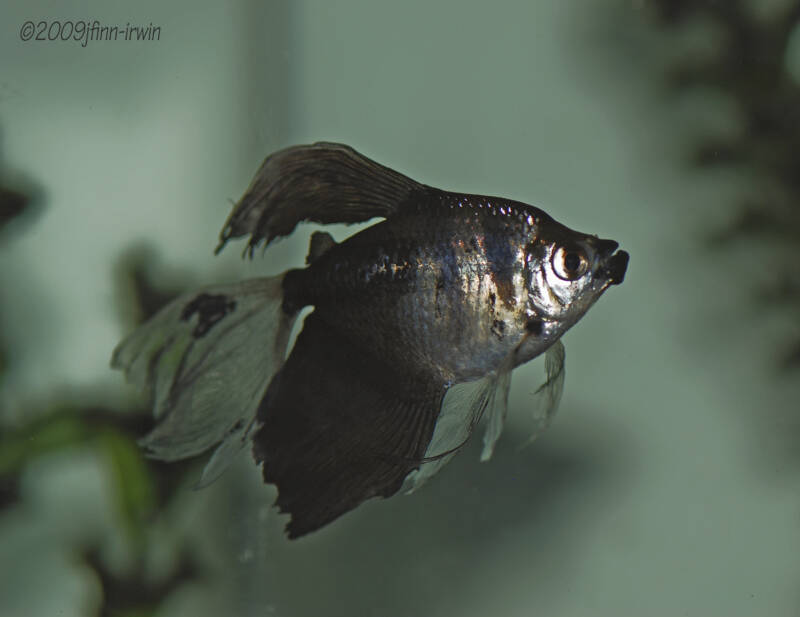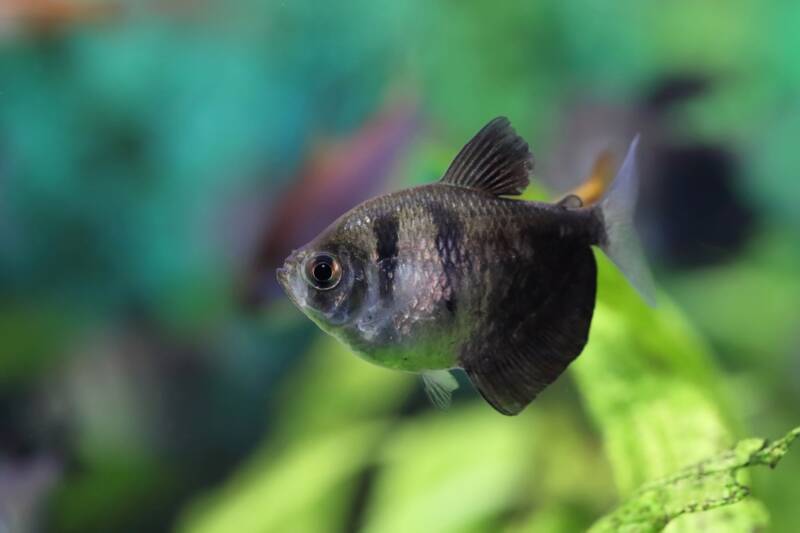Black skirt tetra (Gymnocorymbus ternetzi) share a name with other schooling species like the neon tetra and ember tetra and share their striking coloring, but that’s where the similarities end.
With their large fins and hot temper, these fish are in a league of their own.

These fish are a combination of contradictions: they are small but semi-aggressive, hardy but short-lived, and beautiful but only for a short period.
Black skirt tetras can be easily kept in a species-only or community tank, but aquarists should thoroughly research their care requirements first.
[toc]
Black Skirt Tetra Appearance and Lifespan
These small, two-inch fish are most recognizable for their coloring and fins. They have two or three vertical black stripes on the front half of their body, near their eyes and gills.
They also have very full and long black dorsal and anal fins, hence their common name.
This coloring has also given rise to a second, similarly-apt nickname: the black widow.
But upon reaching maturity (generally the one-year mark), only one of these characteristics will remain: their colors will gradually fade and eventually leave behind a pale coloring.
This pale coloring will stay with them for the majority of their life, which can range from 3 to 5 years.
Natural Habitat and Behavior
In the wild, black skirt tetras can be found in large schools in southern Brazil, Argentina, and Bolivia.
They inhabit warmer waters that may have a low to high water flow and feature a variety of other inhabitants. Despite this, they are generally territorial and somewhat aggressive and will drive off even larger species during the mating season.
Black skirt tetras prefer areas with both heavy plant cover and space for open swimming so that they can hide and chase in turn. This species is naturally curious and enjoys exploring the lower levels of water, such as through mazes of tree roots and near the base or middle of plants.
Basic Tank Setup for Black Skirt Tetras
Because of their schooling needs and preference for both plants and open swimming space, it is recommended to house black skirt tetras in aquariums of at least 20 gallons.
Community setups should be housed in larger tanks to avoid territory and mating-driven aggression from all species.
Live plants with broad leaves and a darker substrate recreate their habitat and bring out their more natural behaviors.
Leaf litter and driftwood (specifically with roots or thin branches) are also recommended for optimal coloring and confidence.

Necessary Equipment
Black skirt tetras are not high maintenance fish and will thrive in a variety of environments as long as the water is clean and warm, and they have plants (live or fake) and décor to interact with.
- Lighting: Lighting is required for all aquariums, especially if you use live plants, but black skirt tetras prefer low lighting; because of this, try to use low-light plants and purchase a lighting system that is adjustable or has different modes.
- Filtration: Clean water is a must for all species of fish, regardless of sensitivity or maintenance. Filters are required, though several different types will suffice: hang on back (HOB), undergravel, and internal filters will all work.
- Heating: These fish need warmer water to survive, and so a heater is required to ensure the water doesn’t drop to dangerously cold temperatures. A thermometer is also recommended to ensure the tank is in a comfortable range.
This equipment comes in a range of sizes, capacity, and expenses. Tank owners can purchase the best fit for their budget and aquarium without sacrificing quality.
Aquarium Water Parameters
Despite the relative hardiness of other tetras, black skirt tetras are more sensitive to water parameters and chemical imbalances. As such, weekly water changes and regular testing should occur in order to ensure the tank is healthy and clean.
- Temperature: Warmer water of at least 60°F is necessary, but 70 – 85°F is preferred.
- pH Range: These tetras prefer a slightly acidic to neutral pH, ranging from 6.5 – 7.5.
- dKH Range: Black skirt tetras can thrive anywhere in a range of 4.0 – 8.0.
- Ammonia: Ammonia should be kept under 2 ppm, though even 2 ppm can be harmful.
- Nitrites: Owners should strive to keep nitrites at 0 ppm to avoid health issues.
- Nitrates: Nitrates are the most harmful to fish and should be strictly kept at 0 ppm.
With regular maintenance and care, these water parameters should be easily met and maintained. Back skirt tetras are easily kept in good health and aquarists have the pleasure of focusing on their tank’s inhabitants instead of the tank’s maintenance.
Suitability for Community Tanks
These fish are not as peaceful as their stature and tetra name would suggest.
In reality, they’re semi-aggressive and known for fin-nipping. They should not be housed with other aggressive fish such as cichlids or fish with long fins, such as angelfish or goldfish.
Peaceful species, other schooling fish, and fast swimmers are recommended if you want to keep black skirt tetras among other fish in a community tank.
But keep in mind, black skirt tetras are not only aggressive towards other fish. They’re also often aggressive toward each other, especially the males during the mating season.
However, this self-directed behavior can be reduced with larger tanks and a high female to male ration.
Food and Diet
Black skirt tetras are technically omnivores, as they also eat plant matter and algae, but primarily prefer meatier foods.
They’ll accept frozen, freeze-dried, and live foods. Like many schooling fish, these species have voracious appetites and will also accept flakes and pellets. Some of their favorite meaty foods include:
- Brine shrimp
- Daphnia
- Mosquito larvae
- Bloodworms
- Blackworms
Their small size means that daily feedings of meaty foods are not recommended, as they may overeat.
Instead, a daily diet of lighter, quality flakes with supplemental meat feedings every other day or every 3 days will suffice.
Black Skirt Tetra Breeding
Sexing black skirt tetras can be difficult outside of the mating season, as there are no drastic differences between the two.
Instead, females are a bit bigger and more full-bodied than males, which tend to be more elongated and skinnier. But during the season, these small differences become more noticeable: females will look engorged and rounded.
Mating pairs should be separated into a secondary breeding tank, which should be heavily-oxygenated and have plenty of live plants or synthetic spawning mops for eggs to be scattered in.
There should also be a raised protective layer for the eggs to fall through, such as marbles or a grate. This prevents the adults from eating the eggs, natural behavior that is common in both wild and commercial habitats.
To induce breeding, raise the temperature a few degrees higher than normal and heavily feed the fish live and frozen foods at least twice per day.
Mating chases and egg fertilization should begin within 10 days, after which point the new parents should be returned to the main tank.
Black skirt tetra is free spawning, which means that the eggs will be scattered and left to hatch (or not) without any parental aid.
The eggs will hatch within 36 hours, mature within the month, and reach the peak of their coloration within one year.
In Summary…
Black skirt tetras are not as commercially available or popular as other breeds of tetra, but they are still beautiful and rewarding inhabitants for those that add schools to their tank.
Their aggression may not make them suitable for all beginners, but luckily they are not overly combative and could still coexist peacefully in a community tank.
They are fairly easy to care for and display striking colors and natural behaviors in aquariums that recreate their natural habitat.
Though black skirt tetras may not be to everyone’s preferences, they are an interesting fish to watch and care for once purchased.
And with coloring as striking as their temper, they’re sure not to be forgotten anytime soon!
